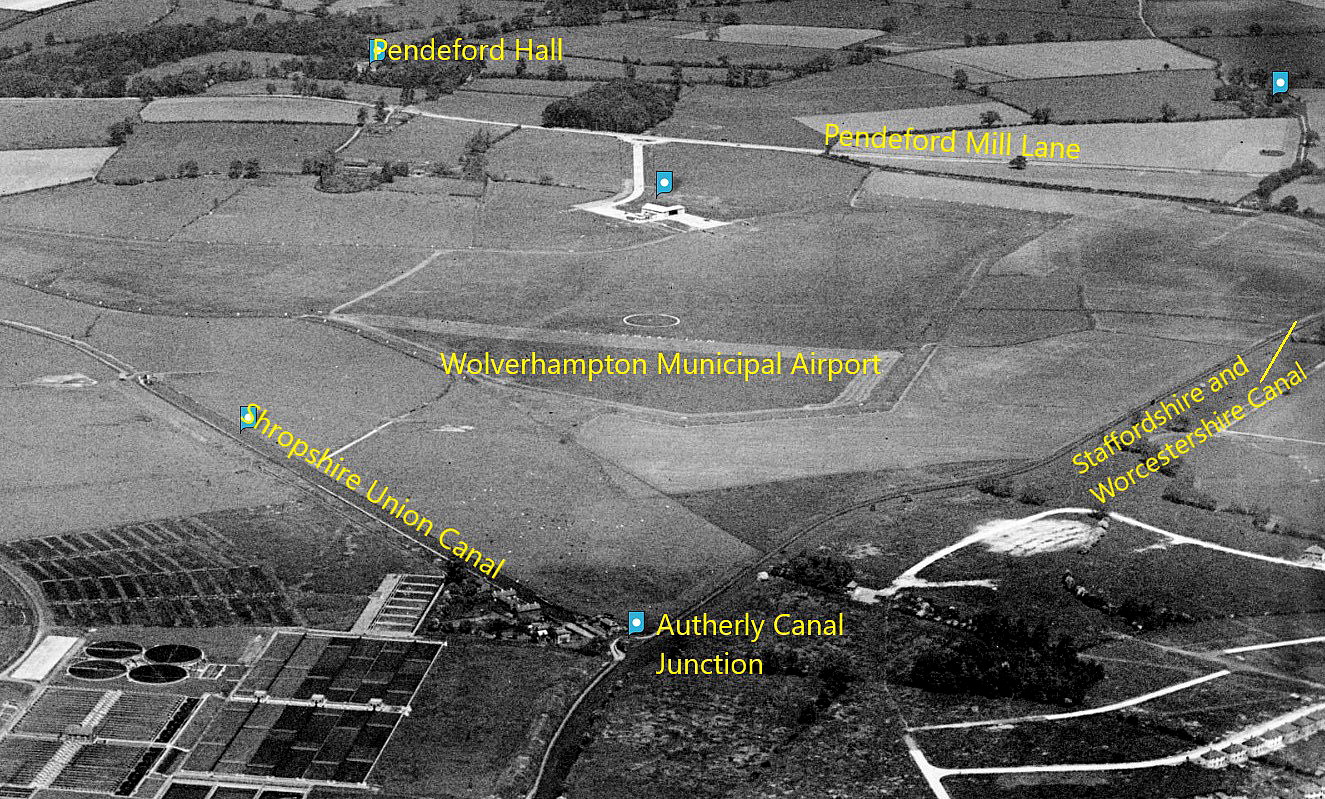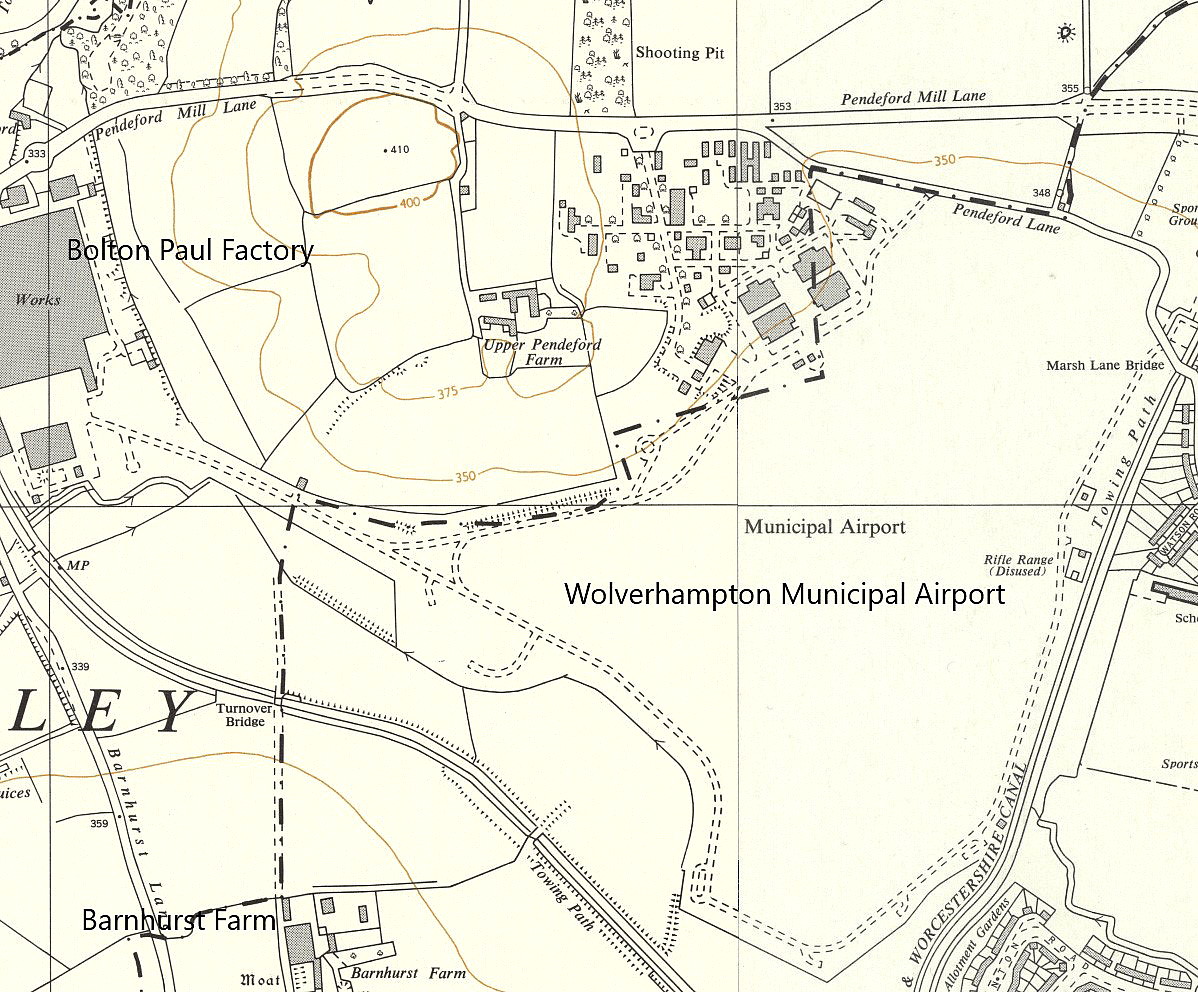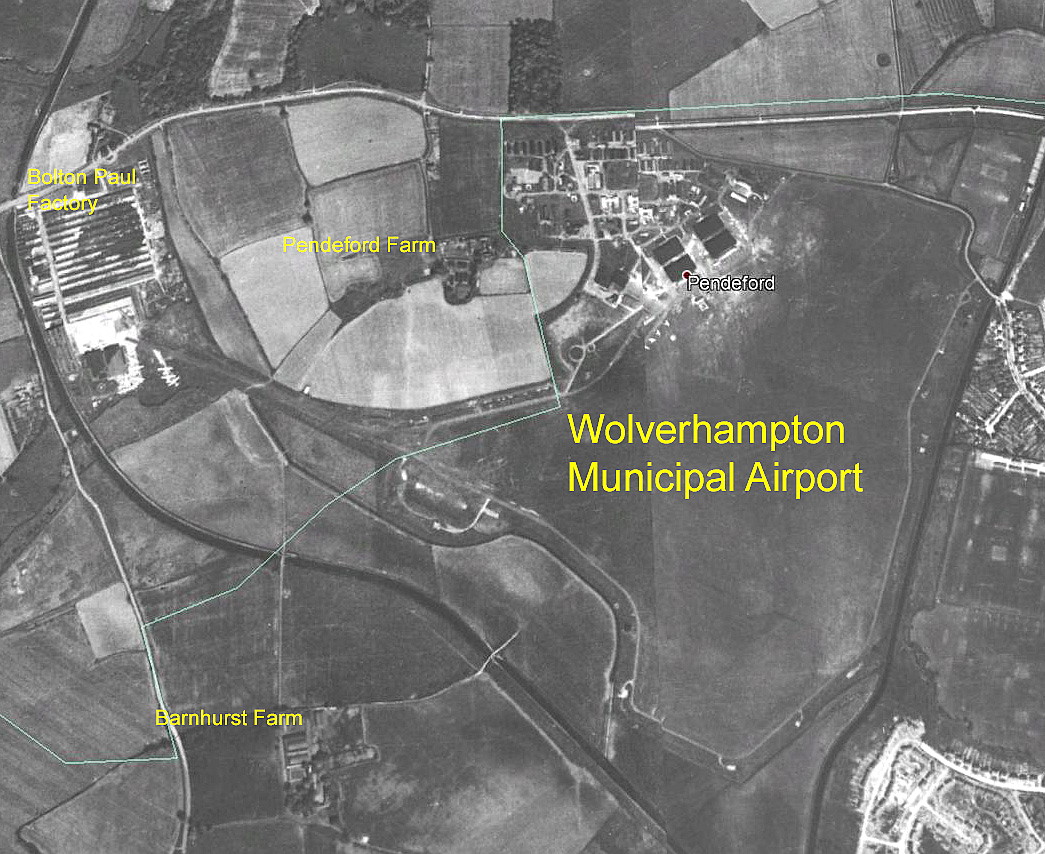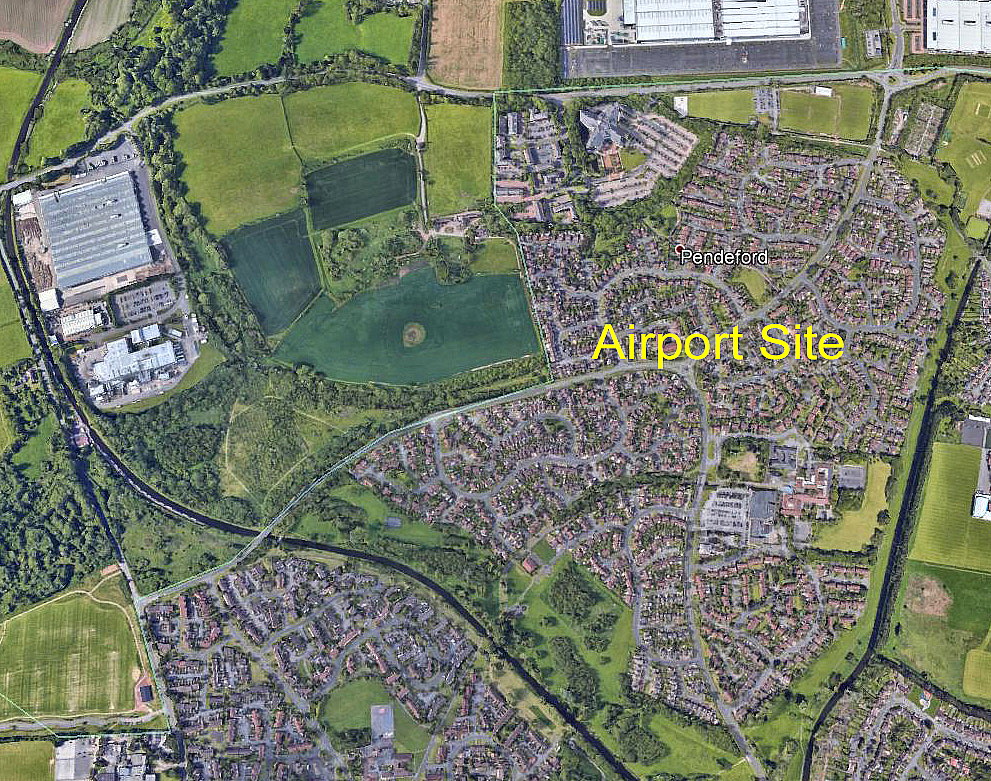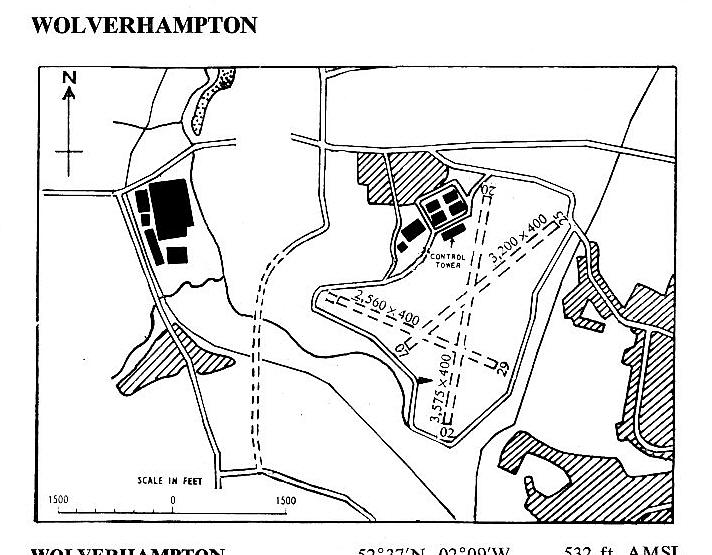Wolverhampton Airport
WOLVERHAMPTON AIRPORT: Civil aerodrome, later military aerodrome and later still regional airport
(Aka as PENDEFORD)
Note: These pictures and maps were kindly provided by Mr Michael T Holder, who is a great friend of this 'Guide'.
Mike also sent this Google Earth © view, which clearly shows that no evidence now exists of this once quite major and really quite important flying site which needs recording in the aviation history of the U.K.
Military user: WW2: RAF Flying Training Command 51 Group
28 EFTS [Elementary Flying School] (DH Tiger Moths) *
Post war: 16 & 25 RFS [Reserve Flying School] (DH Tiger Moths & Avro Ansons)
Manufacturing: Nearby site of the Boulton and Paul factory used 1930s to 1950s?
Operated by:
Post WW2: Wolverhampton Aviation*
1965: Don Everall Aviation Ltd
Location: W of A449, W of Fordhouses, 2nm N of Wolverhampton
Period of operation: 1938 to 1971
Airline users: Post 1945: Derby Aviation, Wolverhampton Aviation
Charter/air taxi: Post 1945: Don Everall (Aviation), Wolverhampton Aviation
Note: In the 1957 The Aeroplane directory the Don Everall (Aviation) fleet comprised three DH89A Dragon Rapides, one Miles Messenger and one Auster Autocrat
Flying club: 1959 ‘snapshot’. Bircher Flying Group, Chaddersley Flying Group, Highfield Flying Group, Thirty-Two Group, Wolverhampton Aero Club
Note: In the 1957 The Aeroplane directory, the Hobson Flying Club were listed as being based here. On the other hand the Wolverhampton Aero Club declared they were operating Austers, Miles Hawks, (presumably Hawk Trainers or civil versions of the Miles M.14 Magisters as the RAF called them), a Miles M38 Messenger, Miles M.65 Gemini's and de Havilland DH89A Dragon Rapides. Quite a formidable fleet in those days, equalling in some ways several of the regional airlines.
The Rapides are of especial interest. Presumably they were used for commercial operations? If anybody can kindly offer advice, this will be most welcome.
Note: This map is reproduced with the kind permission of Pooleys Flight Equipment. Copyright Robert Pooley 2014.
Runway: WW2: E/W 960 grass
1965: 02/20 1090x122 grass 07/25 975x122 grass 11/29 780x122 grass
NOTES: *It appears that in 1941 Air Schools based at BURNASTON AIRPORT (DERBYSHIRE) were invited by the Air Ministry to run this operation. 28 EFTS being operated by Wolverhampton Flying School Ltd. Initially de Havilland DH.82A Tiger Moths were operated, being superseded by Miles Magisters. Up to 72 aircraft were being operated in full flying trim. In fact it appears, at one point there were 108 aircraft ‘on charge’ at both PENDESFORD and BURNASTON. Such numbers operating on intensive flying training at one site seems inconceivable today and there surely must have been frequent serious crashes often fatal judging from records obtained elsewhere. But, at the time such levels of casualties were viewed as being quite acceptable.
THE DEFIANT
It is claimed that 1082 Boulton Paul Defiants took their maiden flights here between 1937 and 1943. As a singular aircraft type/design it certainly deserves a mention for being not only unique but for playing a big part in the night fighter home defence role. In which capacity it is claimed to have been utterly ineffectual. Indeed, as a widely deployed front line type in the early years of WW2 it certainly can lay claim to being the most ineffectual fighter ever to enter service with the RAF. It was originally a day fighter and initially it did have some success for a brief period. However, mainly because it had no forward firing armament, the Luftwaffe pilots quickly found it could easily be shot down, especially if attacked from beneath.
WOLVERHAMPTON AVIATION
*In around 1950 Wolverhampton Aviation (a wholly owned subsidiary of Derby Aviation based at BURNASTON/DERBY AIRPORT), built five Miles Gemini’s and converted six military Miles Messenger 1’s to civilian 4A’s for Miles Aircraft based at WOODLEY (BERKSHIRE).
In his book ‘British Midland Airways’ B G Cramp gives a listing published in 1978:
Messenger 1’s converted to Messenger 4A’s
Serial No. Civil reg: Remarks
RH377 G-ALAH Preserved in non-flying condition by the Northern Aircraft Aircraft Preservation Society
RH421 G-ALAE Damaged beyond repair at Epping 2-8-58
RH422 G-ALAG Crashed Germany 30-12-57
RH423 G-ALAI W.F.U. (Withdrawn from use) 1970
RH425 G-ALAR To New Zealand Feb. 1954 as ZK-BED
RH429 G-ALAJ Wrecked Christchurch, Hants. 29-7-56
Gemini 3A’s
Civil reg: Remarks
G-AMDE Crashed Sibson, Warks. 24-9-67
G-AMGF Broken up, Heathrow 1963
G-ALMU W.F.U. 1967
G-AMKZ Transferred to Sweden as SE-CMX August 1961
G-AMME W.F.U. 1971
No doubt some readers might be wondering why so many classic Miles light aircraft seemed to last barely two decades. The reason for this is because they were not envisaged to last more than twenty years at best and the wood and glue method of construction pretty much guaranteed a short service life. However, without exception all Miles light aircraft designs appear to have performed far better than most competing types (?). It says a lot for the few forward thinking individuals who realised this and determined to preserve examples so that we can still see these aircraft flying today.
AIR RACES
I like this story; in August 1950 a two day air race meeting was held here. In fact these were often held at regional airports such as ELMDON and HURN for example. So what happened to the commercial activities when these events took place? Were these movements fitted in around the races or vice versa?
In some air races of that period the latest jet fighters took part. Can you imagine anything like this happening today? Indeed, it now appears the King’s Cup Race was held here on the 17th June 1950. Thirty-six aircraft competed over the 186 mile course and Mr Edward Day won the event in the Miles M.14 Hawk Trainer 3, G-AKRV, at an average speed of 138.5mph. It must be borne in mind that the King’s Cup is a ‘handicap’ race, so the aircraft capable of the fastest speed is far from assured a winning place.
THE GOODYEAR TROPHY MEETING (1952)
It is of course quite appropriate that Goodyear sponsored the meeting in June 1952 as their factory was, and still is (?), located nearby. In Tails of the Fifties, an anthology compiled by Peter G Campbell, this contribution was made by John Bagley: “The Wolverhampton Club laid on its usual excellent weather on May 17th in honour of this event, and several interesting machines turned up. The meeting opened with formation aerobatics by three pilots from 25 RFS, (my note: Reserve Flying School), flying Tiger Moths DE955 ‘15’, NM185 ‘19’ and R5123 ‘14’. This was followed by some T.A. types who leapt from a balloon (with the aid of parachutes) after which F/Lt. Radley did a hedge-hopping stunt with the RAE’s last Fieseler Storch VP546.
This was followed by the production Balliol T.2 WF989 flown by Boulton-Pauls test pilot. Ranald Porteous then did the ‘usual’ with a newly-registered Aiglet Trainer G-AMMS, and a Wyvern T.4 VW882 was flown across from Bitteswell and demonstrated by an Armstrong Siddeley test pilot.” This latter remark seems a bit odd as the Wyvern was a Westland design – but perhaps being built by Armstrong Siddeley. at BITTESWELL?
It is quite probably just an age thing, and no doubt imbued with lashings of nostalgia, but don’t events such as these now seem quite wonderful when viewed today. I strongly suspect that today the nearest we can get to the atmosphere of those days is probably the air shows held by the Shuttleworth Trust at OLD WARDEN?
“The race itself began at 15.00 hrs when the Piper Cub G-AIYU was flagged off. There were twenty starters; the Comper Swift G-ABUS and Hawk Trainer 3 coupé G-AKRV did not turn up. There were no spectacular excitements, but a satisfactory close finish showed up neat handicapping. Pat Fillingham was first in Chipmunk G-AKDN, hotly pursued by Hawk Trainer 3 G-AJJI which overtook Autocar G-AJYY on the aerodrome boundary.” For younger readers the Hawk Trainer was a civil version of the RAF Miles Magister and the Autocar was an Auster type. "After this the two Messengers G-AJOE and G-AJYZ together with Fred Dunkerley’s Gemini came across in close formation.” These were also Miles designs and it is often forgotten that before 1943 Miles designs were produced, at WOODLEY (BERKSHIRE) by Phillips & Powis. I have a book, published in March 1944, in which the Magister was still being referred to as the Phillips & Powis Miles M.14 Magister.
“After a longish pause the rest of the field came in in the following order: Gemini 3 G-AKDC, Hawk Speed Six G-ADGP, Falcon G-AEEC, Proctor 5 G-AHWR, Chilton G-AFSV, Plus D G-AHGZ, Hawk Trainer 3 G-AKPE, Aiglet Trainer Special G-AMOS, Falcon G-ADTD, Autocrat G-AIGH, Moth Minor G-AFPN and Globe Swift G-AHUU.”
This list shows just how strong the Miles types were in air racing during those days; the Hawk Speed Six and the Falcon also being Miles designs. The Aiglet and Autocrat were Austers and the Moth Minor a de Havilland design. Probably the most interesting type was the Globe Swift which had been imported from the USA, and was of all-metal construction, and, quite possibly with a monocoque fuselage? Either way it is the first mention I have come across of an American all-metal light aircraft design arriving in the UK. Therefore preceeding the first Beechcraft and Cessna types of similar construction. Piper caught up later, their first ‘rag-wing’ imports such as the PA-22 Colt, Caribbean and Tri-Pacer being rather similar to Auster types in construction except for having a tricycle undercarriage.
A MYSTERY?
So, how exactly did this Globe Swift arrive in this country? It appears the first examples were built in 1940 before the USA became involved in WW2 and import restrictions of US light aircraft didn’t end until the very late 1950s. If anybody can solve this apparent mystery I would be delighted to learn about it.
GETTING BACK TO THE RACE
“The Avro 621 Tutor G-AHSA ‘Waltzing Matila’ and the Cub G-AIYU both retired, but both landed back at Wolverhampton with no visible faults. The only non-standard mods observed were Hawk Trainer 3 G-AKPE and Moth Minor G-AFPN, both having the rear cockpit faired in. The Hayhow Aiglet G-AMOS was still crammed with extra tanks, Decca Navigator and similar impediments, named ‘Liege Lady’.” Look at my listing for FAIROAKS (SURREY) to see the amazing series of record breaking flights Tom Mayhow made.
“After the race the Storch towed an all-blue Olympia of the RAF Gliding and Soaring Association (RAE Flight) for an aerobatic display by F/Lt Radley (my note: Radley flying the Storch). This machine carries its constructor’s number ‘EON 086’ on the fuselage sides, and appears to be frustrated export – all cockpit notices are in Spanish.” EON refers to Elliotts of Newbury, then a well known maker of gliders/sailplanes. “Individual displays were then given by Tiger Moth R5237 ‘21’ of 25 RFs, and a Meteor T.7 which closed the show with a magnificent inverted loop.” Those were the days!
KINGS CUP AIR RACES
I find, and I trust you will agree, that looking at the winning aircraft types of these races makes for very interesting reading. As are the venues, all of which in the early days especially, hark back to a largely forgotten era. Combined with info from Wikepedia and other sources, (and for what it is worth), the basic details of the King’s Cup Air Races are as follows:
Note: The table will be added later to bring everything into line.
Year Venue Distance Winner Aircraft type Identity Avge. Speed
(in miles) (in MPH)
1922 CROYDON 810 F. L. Barnard Airco DH.4A G-EAMU 123.6
1923 HENDON 794 F.T. Courtney A.W. Siskin II G-EBEU 149
1924 LEE-on-SOLENT 950 A.J.Cobham DH.50 G-EBFN 106.6
1925 CROYDON 1,608 F.L. Barnard A.W. Siskin V G-EBLQ 141.7
1926 HENDON 1,464 H. S. Broad DH.60 Moth G-EBMO 90.4
1927 HUCKNALL 540 W.L. Hope DH.60 Moth G-EBME 92.8
1928 BROOKLANDS 1,097 W.L. Hope DH.60 Moth G-EBYZ 105.5
1929 HESTON 1,170 R.L.R. Atcherley Gloster Grebe II J7520 150
1930 HANWORTH 753 Miss W Brown Avro Avian III G-EBVZ 102.75
1931 HESTON 983 E.C.T. Edwards Blackburn Bluebird G-AACC 117.8
1932 BROOKLANDS 1,223 W.L. Hope DH83 Fox Moth G-ABUT 124.25
1933 HATFIELD 831 G. de Havilland Leopard Moth G-ACHD 139.51
1934 HATFIELD 801 H.M. Schofield Monospar ST-10 G-ACTS 134.16
1935 HATFIELD 801 T. Rose M.3B Falcon Six G-ADLC 176.28
1936 HATFIELD 1,380 C.E. Gardner Vega Gull G-AEKE 164.47
1937 HATFIELD 1,443 C.E.Gardner Percival Mew Gull G-AEKL 233.7
1938 HATFIELD 1,102 A. Henshaw Percival Mew Gull G-AEXF 236.25
Racing was suspended, as was all private flying, for the duration of World War Two and no doubt due mainly to severe petrol rationing did not restart until 1949. Even then petrol rationing was just starting to ease off, which is why, I would imagine, the very short race course of only sixty miles was flown that year.
1949 ELMDON 60 J.N.Somers Miles Gemini G-AKDC 164.25
1950 PENDEFORD 186 E. Day MilesHawk Trainer G-AKRV 138.5
For some reason, (can anyone explain this?) the King’s Cup Races were cancelled for 1951.
1952 WOOLSINGTON 131 C. Gregory Taylorcraft Plus D G-AHGZ 113.5
1953 ROCHFORD 59 W. Fillingham DHC-1 Chipmunk G-AKDN 142
1954 BAGINGTON 68 H. Wood Miles Messenger G-AKBO 133
1955 BAGINGTON 68 P.S. Clifford Percival Mew Gull G-AEXF 213
1956 BAGINGTON 68 J.H. Denyer Auster J/1N Alpha G-AJRH 124
1957 BAGINGTON 41 F. Dunkerley Miles Sparrowjet G-ADNL 228
1958 BAGINGTON 72 J.H. Denyer DH.82A Tiger Moth G-AIVW 118.5
1959 BAGINGTON 72 A.J. Spiller Percival Proctor G-AHFK 143
1960 BAGINGTON 69 J de M.Severne Druine Turbulent G-APNZ 109
1961 BAGINGTON 72 H.B. Iles Miles M.18 G-AHKY 142
1962 BAGINGTON 67 P.S. Clifford Tipsy Nipper G-ARDY 101
1963 BAGINGTON 72 P.G. Bannister Tipsy Nipper G-APYB 102.5
1964 BAGINGTON 72 D.M. Hartas LeVier Cosmic Wind G-ARUL 185
1965 BAGINGTON 40 J Steward-Wood Cessna 172 G-ARYS 131.5
1966 BAGINGTON 66 J.A.C. Miles DHC-1 Chipmunk G-APTS 135
Perhaps the rules had been changed? The entry of the North American P-51D Mustang WW2 fighter N6356T marks the first entry of a foreign registered aircraft in the King’s Cup, although it was certainly based in the UK .
1967 TOLLERTON 75 C.B.G. Masefield P-51D Mustang N6356T 277.5
1968 TOLLERTON 79 F.R.E. Hayter DH.87B Hornet Moth G-ADKM 121
1969 ROCHESTER 50 R. D’Erlanger Druine Turbulent G-ASAM 99.5
1970 TOLLERTON 95 M. Pruden 7ECA Citabria N7566F 129.5
1971 WHITE WALTHAM 155 J. Bradshaw Percival Provost G-AWPH 204.5
1972 BOOKER 120 S. Warwick Glos-Airtourer G-AZBE 164.5
1973 CRANFIELD 112 H.W. Bonner DHC-1 Chipmunk G-ARWB N/A
1974 TEES-SIDE ? J. Behrman PA-24 Comanche ? 186.6
1975 BAGINGTON 68? J. Cull Bölkow Junior ? 128.66
1976 BAGINGTON 102 A.J. Spiller Cessna 180 G-ASIT 162.89
1977 BAGINGTON ? A. Chadwick Rollason Beta G-AWHX 197.19
1978 THRUXTON 102 J. Stewart-Wood Piper PA-34 Seneca G-BDRI 200.48
1979 JURBY, IoM ? I. Dalziel Miles Falcon Major G-AEEG 136.3
In 1980 the King’s Cup was held at RAF FINNINGLEY and the event was repeated there for the next three years. This is the only example since World War Two of the Race being held at an operational RAF Station and in 1984 it was held at RAF St ATHAN. Prior to this the only operational RAF Station hosting the event was RAF HENDON in 1923 and 1926.
1980 FINNINGLEY 103 A.J. Spiller Cessna 180 G-ASIT ?
1981 FINNINGLEY 103 Ms J. O’Donnell PA-18 Super Cub G-NICK 102
1982 FINNINGLEY ? G. Richardson Bölkow Monsun G-AZOB 154.81
1983 FINNINGLEY 105 D. Sainsbury Cherokee Arrow ? 166.54
1984 St ATHAN ? K. Fehrenback ? ? ?
From this point the records appear to break down, with no course length details until 2011. A lot of aircraft types and registrations appear missing, plus the average speeds attained. If anybody can assist in filling in these gaps it will be much appreciated.
1985 SHOREHAM G. Franks SIAI-Marchetti SF.260 G-BDEN
1986 THRUXTON S/Ldr C. Hilliker
For some unexplained reason the King’s Cup Race was not held in 1987. Why?
1988 LEICESTER S/Ldr M. Baker
This seems very odd, it appears the race resulted in a draw. The first time this has ever happened in the history of the race.
1989 LEICESTER R. Hayes & R. Nesbitt
1990 LEICESTER A. Hawley
1991 LEICESTER S. Jones
1992 LEICESTER P. Crispe Cessna Skymaster G-AWVS
1993 LEICESTER R. Hayes
1994 LEICESTER G. Boot Cessna 340 N66SW 220
1995 LEICESTER D. Soul
1996 LEICESTER E. Coventry
In 1997 Ms. Melanie Willes won the King’s Cup Air Race, the third woman to do so. The first was Miss Winifred Brown in 1930 and it was another fifty-one years before Josephine O’Donnell won the race in 1981 at RAF FINNINGLEY.
1997 LEICESTER Ms. M. Willes
It appears there was no King’s Cup Air Race in 1998. Can this be explained?
1999 LEICESTER R. Hayes
2000 LEICESTER M. Konstantinovic
2001 LEICESTER J. Spooner Cessna 182 G-CBIL
2002 LEICESTER S. Ollier
2003 LEICESTER G. Boot Beagle Pup G-TSKY 131
2004 LEICESTER P. Wadsworth
2005 SHOBDON R. Hayes
2006 SHOBDON N. Reddish Vans RV-7 G-SEVN
2007 SYWELL N. Cooper Beagle Pup G-IPUP
2008 SYWELL N. Reddish Vans RV-7 G-SEVN
2009 SYWELL R. Marsden Vans RV-6 G-TNGO 190
2010 SYWELL R. Morton Slingsby Firefly G-KONG
2011 SYWELL 120 M. Montgomerie Cessna 152 G-BJWH 116
2012 SHOBDON 97 G. Bellerby Grumman Tiger G-BXFW 124.5
I think it should be explained, especially to younger readers of this ‘Guide’ that air racing, certainly since the great ‘Air Meeting’ at Rheims in 1909, was, before World War Two, arguably the major influence in getting aircraft to fly faster. In those days it made quite an impact on military fighter design. Since WW2 air racing has become a sport activity, much enlivened with a handicap system which means, as can be seen by looking at the lists above, that the fastest aircraft don’t usually win!
AIRLINES AT PENDEFORD
It appears that Derby Aviation first used Rapides from here, later DC-3 Dakotas. Apparently Don Everall (Aviation) started out from here operating one light aircraft. In 1959 the Don Everall fleet was:
De Havilland DH.89A Dragon Rapides G-AGDP, G-AHPT & G-AKZO
Douglas DC-3 Dakotas G-AMSF & G-ANEG
(I feel certain they also operated Vickers Vikings?)
Tim Foster
This comment was written on: 2020-01-19 15:54:33This site brought back a few memories I was born (in 1940) and brought up in a small (and I mean small) village about 4 km north of Pendeford so I became quite familiar with the site over a number of years. Indeed, my first flight was from there in 1950, when I was 9 years old, in a Don Everall Aviation Dragon Rapide, 10 shillings (50p) for 10minutes. After that I was hooked. This was the same year that the Kings Cup Air race was held and I recall seeing Ron Payne in his Hawk Speed Six G-ADGP race no.96. I also recall seeing Percival Mew Gull G-AEXF but I don't think it was at that event. It may have been at a Goodyear Trophy Race. I recall that Boulton Paul flew Balliols out of Pendeford and in 1948, before I took much interest in aviation I witnessed a tragic event. I was playing in the lane outside my home, kicking a tin can about probably, when I heard the sound of a plane engine at high power. This soon after the end of the war lots of planes were about but this sounded different. I looked up and to the South saw a plane diving steeply down. As I watched, it pulled up and climbed vertically into cloud. A few seconds later it reappeared in a tailslide then flipped over. dived vertically and disappeared behind the tree line. A mighty explosion followed. I was terrified and thought the war had restarted. I ran indoors and told my mother what I had seen but needless to say she was a bit sceptical. Anyway, the next day the local rag, the Wolverhampton Express and Star reported that a Balliol on a test Flight had crashed killing both crew members. Later reports said they had been carrying out high speed dive tests and the windscreen had blown in.
John Newman
This comment was written on: 2020-02-24 17:12:00I remember an Auster aeroplane crashing in a garden in Sandy lane Codsall not far from Codsall high school. I was just a young lad in those days but I went to see the Auster upside down in a garden. I was told that the pilot just suffered a broken nose. I know that a picture of the plane was taken. I can find no recollection of this accident.
We'd love to hear from you, so please scroll down to leave a comment!
Leave a comment ...
Copyright (c) UK Airfield Guide














